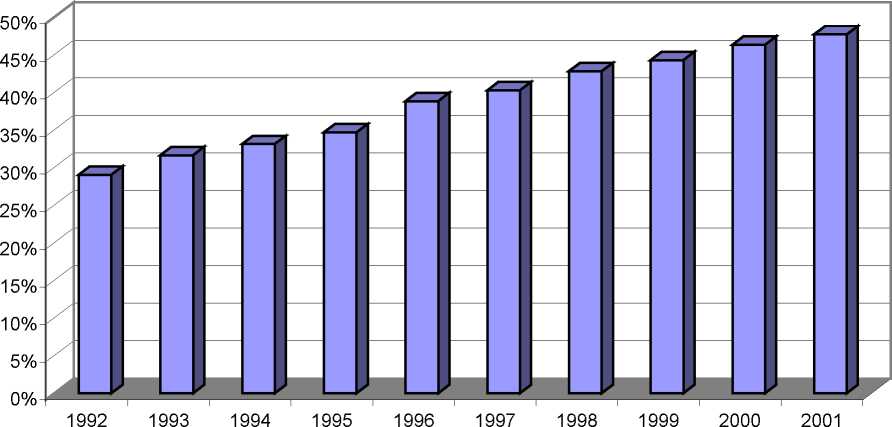As to actual coverage, the perceived effect of regulation is a bit clearer. In this paper, coverage is
defined as the percentage of electricity consumers in a population. Figure 3.2 shows national
coverage for the period 1992 - 2001. An increase of 19% coverage is observed between these
two years, with an average yearly growth rate of around 2.1% for the period. There is a jump in
coverage of 4 percentage points between 1995 and 1996, which might be attributed to initial
compliance of newly privatized enterprises with agreed-upon contract clauses that required a
broadening of services throughout the country. The increase in coverage between the two end
years represents around 430 thousand new homes with access to electricity, which, according to
national statistics, represents approximately 1.9 million new people with access to this basic
commodity.
Figure 3.2
National Coverage

Source: INE
A more interesting result occurs when disaggregation of national data takes place. Growth rates
in coverage are now calculated for three different groups of deparments. The first group (Group
1) includes La Paz, Cochabamba and Santa Cruz, the biggest and, on aggregate terms, the ones
that contribute most to national income. The second group (Group 2) - which may also be
referred to as the “stagnant group“ - includes the departments of Chuquisaca, Oruro and Potosi,
and it represents middle-sized deparments whose economic performance has been comparatively
poorer than the rest of the country. The final group (Group 3) is composed of Tarija, Beni and
11
More intriguing information
1. Structural Conservation Practices in U.S. Corn Production: Evidence on Environmental Stewardship by Program Participants and Non-Participants2. The name is absent
3. The name is absent
4. AN ECONOMIC EVALUATION OF THE COLORADO RIVER BASIN SALINITY CONTROL PROGRAM
5. The name is absent
6. WP 1 - The first part-time economy in the world. Does it work?
7. DISCUSSION: ASSESSING STRUCTURAL CHANGE IN THE DEMAND FOR FOOD COMMODITIES
8. A multistate demographic model for firms in the province of Gelderland
9. Tobacco and Alcohol: Complements or Substitutes? - A Statistical Guinea Pig Approach
10. The Making of Cultural Policy: A European Perspective